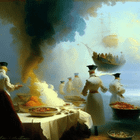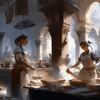The development of global cuisine spans thousands of years, resulting in tens of thousands of dishes created throughout history. Countless books have been written about food, enough to fill a lifetime of reading. The primitive cuisine of early civilizations underwent a long and challenging journey of evolution, eventually transforming into the refined Culinary Arts that absorbed the achievements of modern science.
The history of humanity, from ancient times to the present day, has witnessed remarkable peaks and drastic declines in the culinary arts. Food has been elevated to heavenly status, considered one of life's greatest pleasures, while at times, it has been regarded with disdain, deemed unworthy of a true gentleman's discussions. Take the ancient Greeks, for instance. In Sparta, meals were modest as simplicity was valued, especially during expeditions and wars. Just a stone's throw away in Athens, culinary enthusiasts honed their skills in preparing extraordinary festive dishes. Tiny olives were baked inside doves, doves within kid goats, kid goats within sheep, and sheep within bulls, all roasted on a spit, with the esteemed guest receiving the coveted olive.
It is hardly surprising that Ancient Rome witnessed the flourishing of culinary arts, predominantly influenced by Greek chefs. Cooks held high esteem, as the prestige of noble households depended on them. During the Second Punic War, there were even uprisings by chefs who seized control of certain cities. Under the reigns of emperors Augustus and Tiberius, the first culinary schools were established, led by the renowned master of the cauldron and kitchen, Apicius. Consequently, some emperors were known for their excessive indulgence in food. For example, during the reign of Vitellius, a dish worth a fortune—equivalent to a million sesterces—was prepared, made from the brains of pheasants, peacocks' tongues, flamingo livers, and the rarest fish of that time.
Following a prolonged stagnation period, the refined cuisine experienced further development thanks to the widespread introduction of spices from Eastern colonies at the end of the Middle Ages. Italy, especially the southern regions and Sicily, became the cradle of exquisite cuisine.
During the reign of King Louis XIV, France witnessed a significant resurgence in culinary arts, and ever since, European countries have engaged in relentless culinary rivalry.
The development of culinary arts involved not only professional chefs but also many scientists, philosophers, and statesmen. It is known that inventors of new dishes included Richelieu, Mazarin, and Michel de Montaigne, who wrote the book "The Science of Eating." To this day, Italian restaurants feature dishes invented by the composer Rossini. France takes pride in the culinary contributions of Alexandre Dumas père and the great Balzac.
In the 19th century, culinary schools began to emerge one after another. Surprisingly, the first one was established in England—the "National Training School for Cookery"—despite the common belief that the British did not have a strong culinary inclination. This school's opening was likely motivated by economic factors, as small cafes and restaurants proliferated. The culinary school founded in Paris in 1891 had separate departments for women and men. Women received free training in domestic management, while men paid for instruction to master the secrets of professional cooking. They also learned about the history of culinary arts, botany, sculpting, drawing, and accounting.
In the 1890s, Russia saw the emergence of its first practical culinary school, as well as schools of culinary and kitchen arts under public healthcare supervision in Moscow, Odessa, and St. Petersburg. There was much to learn, as traditional Russian cuisine preserved many ancient traditions.
Pies played a significant role, with yeast-based pod-type pies and unleavened fried pies being particularly popular. Russian dishes were enhanced with imported spices, such as saffron brought by Eastern merchants, and garlic.
In the 16th and 17th centuries, onions and garlic were included in the list of products that citizens were obliged to provide to scribes, who maintained records. In ancient Russia, salt consumption was minimal. Ethnographic and economic reasons likely influenced the assortment of Russian dishes. With the exception of dishes made from valuable fish species, pies, and kvass, the Russian cuisine vividly depicted by Gilyarovsky in "Moscow and Muscovites" already featured a prevalence of Western European dishes, accessible only to the most affluent individuals.


















